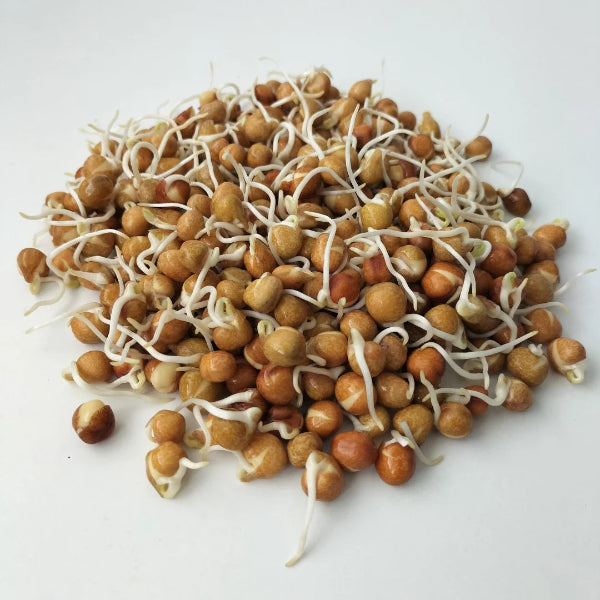Growing microgreens and sprouts are two of the easiest, fastest, most nutritious, and most rewarding things you could possibly grow at home. You may need a green thumb to grow fruits and vegetables but not for sprouts!
Sprouting Pea Seeds:
Pea sprouts offer a fresh, crunchy way to incorporate the nutritional benefits of peas into your diet. Rich in vitamins, antioxidants, and key minerals such as folate, iron, and magnesium, they provide a valuable source of plant-based protein, fiber, and essential vitamins A, C, and K. Regular consumption of sprouted peas may support digestive health, bolster immune response, and promote cardiovascular wellness. Their naturally sweet flavor complements a variety of dishes including wraps, salads, stir-fries, and sandwiches. These sprouts can be cultivated year-round, with a quick harvest time of just 3 to 5 days.
How to Grow Pea Sprouts:
- Pre-soak seeds for 8-12 hours or overnight.
- Sterilise your Glass Sprouting Jar in dishwasher or with soap and hot water.
- Rinse seeds well in cool water. (It is particularly important to rinse seeds well in humid weather).
- Put 20-30g of seeds in your sprouting jar. This will yield 1.5-2 cups of sprouts.
- Fill jar with cool water and soak for 4-6 hours.
- Rinse and drain seeds well in cool water.
- Leave Sprouting Jar upside down on an angle to allow water to drain. Leave for 8-12 hours.
- Rinse and drain twice a day until harvest - approximately 4-5 days.
Sprouting Pea Seed Details:
- Contains Australian Grown Field Peas - Pisum sativum
- Non-GMO.
- Open-pollinated.
- No chemical treatment.
Health Benefits of Microgreens and Sprouts
- Incredibly nutrient dense and low in calories. One study found that "some microgreens contain up to 40 times higher levels of vital nutrients than their mature counterparts" [1].
- Makes seeds easier to digest.
- Essential minerals and nutrients contained within the seeds/legumes become more bioavailable after sprouting (i.e. the nutrients become easier for your body to absorb and use).
- Delicious addition to a salad, sandwich, smoothie or other meal. Add a crunch or a peppery zing depending on the type you choose (see a list of different microgreens/sprouts and their tastes here).
What's the Difference Between Microgreens and Sprouts?
Both microgreens and sprouts are the young shoots of germinated seeds - essentially baby plants. You can grow grains, legumes, nuts and seeds as sprouts or microgreens and people are now fully realising the benefits of eating these young plants.
Sprouts are not grown in soil or other growing medium but rather are germinated with only water, usually in a jar or on a paper towel. They do not need light but require rinsing/misting at least twice per day, are ready to eat in 3-5 days and both the seed and plant are consumed.
Microgreens are grown in soil, a hydroponic growing pad or another growing medium such as cocopeat. They require light, are usually ready to eat in 5-15 days depending on what you're growing, and are generally cut off above the soil so only the stems and leaves are consumed.
For further information see our article - 5 Ways To Grow Microgreens and Sprouts
How to Store Microgreen and Sprouting Seeds
Store seeds in a cool, dry place (under 10°C) or in an airtight container in the fridge. Do not expose to moisture or direct sunlight, Grains, cereals & pulses should be refrigerated.
Some of our Microgreen Seeds
- Snow Pea Oregon Sugar Pod
- Coriander Microgreens
- Beetroot Microgreens
- Basil Microgreens
- Australian Black Sunflower Microgreens
- Broccoli Microgreens
- Green Cabbage Microgreens
- Kale Microgreens
- Mung Microgreens
- Mustard Microgreens
- Radish Daikon Microgreens
Where to Put all your Seeds! - Timber Seeds Box
*** Due to quarantine restrictions we are unable to send seeds to Tasmania or South Australia***


